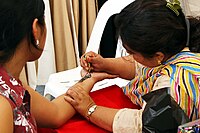Mehandi is the application of henna as a temporary form of skin decoration in India, Pakistan, Nepal and Bangladesh as well as byexpatriate communities from those countries. The word mehndi is derived from the Sanskrit word mendhikā.The use of mehndi andturmeric is described in the earliest Hinduism's Vedic ritual books. Haldi(Staining oneself with turmeric paste) as well as mehndi are Vedic customs, intended to be a symbolic representation of the outer and the inner sun. Vedic customs are centered around the idea of "awakening the inner light".
Traditional indian designs are of representations of the sun on the palm, which, in this context, is intended to represent the hands and feet.
Mehndi decorations became fashionable in the West in the late 1990s, where they are sometimes called henna tattoos. Henna is typically applied during special occasions like weddings and Muslim festivals such as Eid-ul-Fitr and Eid-ul-Adha as well as in Hindufestivals like Karva Chauth, Diwali, Bhaidooj and Teej. In some Hindu festivals, many women have Henna applied to their hands and feet. It is usually drawn on the palms and feet, where the design will be clearest because the skin on these surfaces naturally contains less of the pigment, melanin. Henna was originally used as a form of decoration mainly for brides.
In the modern age, usually people buy readymade Henna cones, which are ready to use and make painting easy. However, in rural areas in India, women grind fresh henna leaves on grinding stones with added oil, which though not as refined as professionally prepared henna cones, brings much darker colors.
The term henna tattoo is figurative, because true tattoos are permanent surgical insertions of pigments underneath the skin, as opposed to pigments resting on the surface as is the case with mehndi.
Likely due to the desire for a "tattoo-black" appearance, many people have started adding the synthetic dye p-Phenylenediamine (PPD) to henna to give it a black colour. PPD is extremely harmful to the skin and can cause severe allergic reactions resulting in permanent injury or death. Alata (Mahur) is a flower-based dye used to paint the feet of the brides in some regions of India. It is still used in Bengal.
Process
Henna paste is usually applied on the skin using a plastic cone or a paint brush, but sometimes a small metal-tipped jacquard bottle used for silk painting (a jac bottle) is employed. After about 15–20 minutes, the mud will dry and begin to crack, and during this time, a mixture of lemon juice and white sugar can be applied over the henna design to remoisten the henna mud so that the henna still stain darker. The painted area is then wrapped with tissue, plastic, or medical tape to lock in body heat, creating a more intense colour on the skin. The wrap(not a traditional method),is worn three to six hours, or sometimes overnight and then removed. When first removed, the henna design is pale to dark orange in colour and gradually darkens through oxidation, over the course of 24 to 72 hours. The final color is reddish brown and can last anywhere from one to three weeks depending on the quality and type of henna paste applied, as well as where it was applied on the body (thicker skin stains darker and longer than thin skin). Moisturizing with natural oils, such as olive, sesame seed, or coconut, will also help extend the lifetime of the stain, as skin exfoliation is what causes the henna tattoo to fade.
Mehndi celebration
Weddings in Pakistan or India can often be long, ritualistic, and elaborate affairs with many pre-wedding, wedding and post wedding ceremonies. The occasion of Mehndi ceremony is often one of the most important pre-wedding rituals especially for the bride. It is a fun filled ritual, which is celebrated mainly by the bride's family. Different regions of the country celebrate the ritual in a different way according to their own marriage customs, rituals, and culture. Mehndi ceremonies take place outside India and Pakistan amongst the Indian/Pakistani community and places like Birmingham in the UK are such known hotspots for lavish Mehndi celebrations.
The ceremony is mainly held at the bride's house or at a banquet hall on the eve of the marriage ceremony or few days before the marriage. Generally the bride and groom attend the event together and on the occasion a professional henna artist or a relative applies mehndi to the bride's hands and feet. The designs are very intricate. Often hidden within the mehndi pattern the name or initials of the groom are applied. The event generally has a celebratory festival feel to it with the women dancing and singing traditional songs and the girls wearing vivid colors such as hot pink and yellow, often if the bride to be wishes to tease her future groom she will make him wear purple. The groom usually wears jutti instead of western footwear.











.jpg)
.jpg)
.jpg)






No comments:
Post a Comment